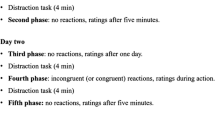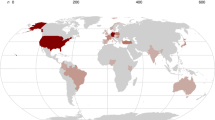Abstract
According to the facial feedback hypothesis, facial muscles do not only express emotions, they also have the ability to modulate subjective experiences of emotions and to initiate emotions. This study examined the voluntary facial action technique, where participants were instructed to react with the Zygomatic major muscle (smile) or the Corrugator supercilii muscle (frown) when exposed to different stimuli. The results demonstrate that the technique effectively induces facial feedback effects. Through use of this technique we further addressed three important areas of facial feedback and found, first, that facial feedback did not modulate the experience of positive and negative emotion evoking stimuli differently. Second, the modulating ability provided significant feedback effects, while the initiating ability did not. Third, an effect of feedback remained and could be detected even some time after the critical manipulation. It is concluded that the present technique can be used in the future study of facial feedback.

Similar content being viewed by others
References
Adelmann, P. K., & Zajonc, R. B. (1989). Facial efference and the experience of emotion. Annual Review of Psychology, 40, 249–280.
Andréasson, P., & Dimberg, U. (2008). Emotional empathy and facial feedback. Journal of Nonverbal Behavior, 32, 215–224.
Buck, R. (1980). Nonverbal behaviour and the theory of emotion: The facial feedback hypothesis. Journal of Personality and Social Psychology, 38, 811–824.
Darwin, C. (1872). The expression of emotions in man and animals. London: Murray.
Dimberg, U. (1982). Facial reactions to facial expressions. Psychophysiology, 19, 643–647.
Dimberg, U. (1986). Facial reactions to fear-relevant and fear-irrelevant stimuli. Biological Psychology, 23, 153–161.
Dimberg, U. (1990). Facial reactions to fear-relevant stimuli for subjects high and low in specific fear. Scandinavian Journal of Psychology, 31, 65–69.
Dimberg, U. (1997). Facial reactions: Rapidly evoked emotional responses. Journal of Psychophysiology, 11, 115–123.
Dimberg, U. (2010). The voluntary facial action technique yields comparable frowns and smiles (Manuscript in preparation).
Dimberg, U., Hansson, G., & Thunberg, M. (1998). Fear of snakes and facial reactions: A case of rapid emotional responding. Scandinavian Journal of Psychology, 39, 75–80.
Dimberg, U., & Karlsson, B. (1997). Facial reactions to different emotionally relevant stimuli. Scandinavian Journal of Psychology, 38, 297–303.
Dimberg, U., Thunberg, M., & Elmehed, K. (2000). Unconscious facial reactions to emotional facial expressions. Psychological Science, 11, 86–89.
Dimberg, U., Thunberg, M., & Grunedal, S. (2002). Facial reactions to emotional stimuli: Automatically controlled emotional responses. Cognition and Emotion, 16, 449–471.
Ekman, P. (1973). Cross-cultural studies of facial expressions. In P. Ekman (Ed.), Darwin and facial expression. New York: Academic Press.
Ekman, P. (1984). Expression and the nature of emotion. In K. Scherer & P. Ekman (Eds.), Approaches to emotion (pp. 319–344). Hillsdale, NJ: Erlbaum.
Ekman, P., & Friesen, W. (1976). Pictures of facial affect. Palo Alto: Consulting Psychologists Press.
Ekman, P., Levenson, R. W., & Friesen, W. V. (1983). Autonomic nervous system activity distinguishes between emotions. Science, 221, 1208–1210.
Flack, W. F., Laird, J. D., & Cavallaro, L. A. (1999). Separate and combined effects of facial expressions and bodily postures on emotional feelings. European Journal of Social Psychology, 29, 203–217.
Frank, M. G., Ekman, P., & Friesen, W. V. (2005). Behavioral markers and recognizability of the smile of enjoyment. In P. Ekman & E. L. Rosenberg (Eds.), What the face reveals: Basic and applied studies of spontaneous expression using the Facial Action Coding System (FACS) (2nd ed., pp. 217–238). New York: Oxford University Press.
Gellhorn, E. (1964). Motion and emotion: The role of proprioception in the physiology and pathology of the emotions. Psychological Review, 71, 457–472.
Hennenlotter, A., Dresel, C., Castrop, F., Ceballos Baumann, A. O., Wohlschläger, A. M., & Haslinger, B. (2009). The link between facial feedback and neural activity within central circuitries of emotion—New insights from Botulinum toxin–induced denervation of frown muscles. Cerebral Cortex, 19, 537–542.
Ito, T. A., Chiao, K. W., Devine, P. G., Lorig, T. S., & Cacioppo, J. T. (2006). The influence of facial feedback on race bias. Psychological Science, 17(3), 256–261.
Izard, C. E. (1971). The face of emotion. New York: Plenum.
James, W. (1884). What is emotion? Mind, 19, 188–205.
Lundquist, L.-O., & Dimberg, U. (1995). Facial expressions are contagious. Journal of Psychophysiology, 9, 203–211.
McIntosh, D. N. (1996). Facial feedback hypothesis: Evidence, implications, and directions. Motivation and Emotion, 20, 121–147.
Soussignan, R. (2002). Duchenne smile, emotional experience, and autonomic reactivity: A test of the facial feedback hypothesis. Emotion, 2, 52–74.
Strack, F., Martin, F. F., & Stepper, S. (1988). Inhibiting and facilitating conditions of the human smile: A non-obtrusive test of the facial feedback hypothesis. Journal of Personality and Social Psychology, 54, 768–777.
Tomkins, S. S. (1962). Affect, imagery, consciousness, Vol. 1. In: The positive affects. New York: Springer.
Tomkins, S. S. (1980). Affect as amplification: Some modifications in theory. In R. Plutchik & H. Kellerman (Eds.), Emotion: Theory, research and experience (pp. 141–164). New York: Academic Press.
Acknowledgments
This study was supported by grants to Ulf Dimberg from The Swedish Research Council and The Bank of Sweden Tercentenary Foundation. We thank Monika Thunberg for helpful comments on the manuscript.
Author information
Authors and Affiliations
Corresponding author
Rights and permissions
About this article
Cite this article
Dimberg, U., Söderkvist, S. The Voluntary Facial Action Technique: A Method to Test the Facial Feedback Hypothesis. J Nonverbal Behav 35, 17–33 (2011). https://doi.org/10.1007/s10919-010-0098-6
Published:
Issue Date:
DOI: https://doi.org/10.1007/s10919-010-0098-6




